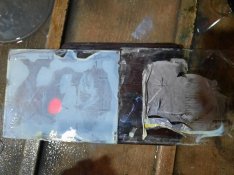Hi can someone tell me the typical time it would take before collodion would start to solidify on a glass plate at 20C?
I've tried 3 times to coat a 4x5 glass plate with store bought collodion mixture and each time it has started to solidify in 10 seconds. Not sure what Im doing wrong. Ive poured it direct from the bottle, poured it quickly onto a plastic 5ml measuring spoon and quickly on the plate and still it is still hardening before I can tilt it to the last corner.
All the vids I've seen seem to have ample time.
If 10 seconds is normal I will need to practice a bit more to speed things up.
Thanks
I've tried 3 times to coat a 4x5 glass plate with store bought collodion mixture and each time it has started to solidify in 10 seconds. Not sure what Im doing wrong. Ive poured it direct from the bottle, poured it quickly onto a plastic 5ml measuring spoon and quickly on the plate and still it is still hardening before I can tilt it to the last corner.
All the vids I've seen seem to have ample time.
If 10 seconds is normal I will need to practice a bit more to speed things up.
Thanks



